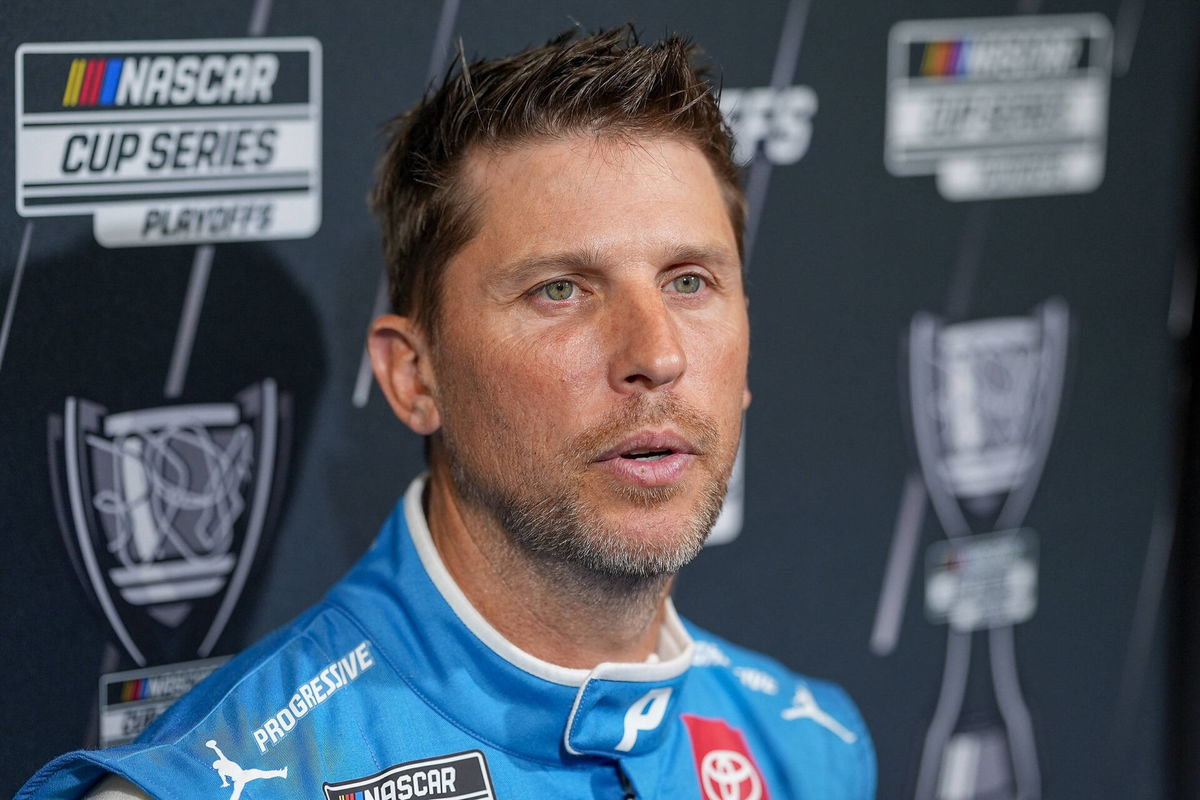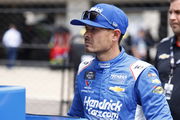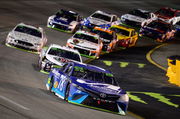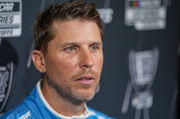
Imago
NASCAR, Motorsport, USA Cup Series Playoff Media Day Aug 27, 2025 Charlotte, NC, USA Denny Hamlin answers questions from the media during NASCAR Cup Series Playoff Media Day at Charlotte Convention Center. Charlotte Charlotte Convention Center NC USA, EDITORIAL USE ONLY PUBLICATIONxINxGERxSUIxAUTxONLY Copyright: xJimxDedmonx 20250827_jla_db2_013

Imago
NASCAR, Motorsport, USA Cup Series Playoff Media Day Aug 27, 2025 Charlotte, NC, USA Denny Hamlin answers questions from the media during NASCAR Cup Series Playoff Media Day at Charlotte Convention Center. Charlotte Charlotte Convention Center NC USA, EDITORIAL USE ONLY PUBLICATIONxINxGERxSUIxAUTxONLY Copyright: xJimxDedmonx 20250827_jla_db2_013
Team Penske’s performance at New Hampshire on Sunday was nothing short of a masterclass. Ryan Blaney led 116 laps for his third win of the 2025 season, while Joey Logano started on pole, led 147 laps, and finished fourth, together controlling 263 of the 301 laps at Loudon. Their dominance wasn’t just about raw speed; it reflected meticulous preparation, strategy, and tire testing that put them a step ahead of every rival, including this year’s favorite, Denny Hamlin. Every Penske car seemed to know the track intimately, making the competition look flat-footed in comparison. But while Penske’s success turned heads, it also raised questions for other top teams: why aren’t others, like Joe Gibbs Racing, capitalizing on similar opportunities to translate testing and setup data into tangible speed advantages?
Watch What’s Trending Now!
Team Penske’s perfect execution at New Hampshire
Team Penske’s dominance at New Hampshire Motor Speedway in 2025 was largely fueled by their exceptional tire testing and data-driven preparation, setting a new standard for playoff performance. Penske conducted extensive tire tests leading up to the race, refining their setups to maximize grip and durability on the demanding one-mile oval. This gave them a critical advantage in understanding how to balance tire wear and performance.
ADVERTISEMENT
Denny Hamlin highlighted the significance of this testing edge when he noted, “You would think that the others would probably base their setups around whatever the 22 team came up with during that test. And what we’ve seen is that Penske’s got a really good test plan.” This meticulous groundwork was a pivotal factor behind Ryan Blaney’s 116 laps led and dominant victory, as well as Joey Logano’s performance at the front of the pack, eventually finishing 4th.

Imago
September 21, 2025, Loudon, Nh, USA: LOUDON, N.H. à Sept. 21, 2025 à RYAN BLANEY 12 leads JOEY LOGANO 22 and CARSON HOCEVAR 77 through turn 3 during Stage 2 of Sundayà s Mobil 1 301 at New Hampshire Motor Speedway in Loudon, N.H., a NASCAR, Motorsport, USA Cup Series Round of 12 race. Loudon USA – ZUMAa232 20250921_zsp_a232_010 Copyright: xJamesxThomasx
In contrast, Joe Gibbs Racing struggled. Denny Hamlin observed, “We missed it by being like the eighth through 13th fastest cars.” JGR’s overall result highlighted the broader issue. Despite competitive balance in practice and simulation, JGR lacked the critical speed advantage, hardly leading any laps in the race. In the end, Christopher Bell managed only 6th place, whereas Briscoe finished 10th. Similarly, Denny Hamlin finished a disappointing 12th after starting 9th. JGR was nowhere close to Team Penske.
ADVERTISEMENT
Hamlin explained, “Certainly something that can be worked with, but man, we just did not have the speed. And so that’s usually a grip problem,” highlighting the minuscule yet decisive difference in tire grip, estimated as “one and a half percent more grip” possessed by Penske’s cars, that translated into a substantial speed advantage on race day.
This grip advantage, born from precise tire management and setup, exposed the rest of the field, leaving Penske’s competitors to chase an elusive benchmark. The team’s flawless integration of tire data into race strategy and car setup exemplifies the scientific precision and preparation that distinguish their playoff performances from the pack. Penske’s New Hampshire success was not just a victory; it reset expectations for technical excellence in the NASCAR playoffs.
ADVERTISEMENT
Top Stories
Kyle Larson Loses $33,000 in Australia Moments After Winning $110,000 Briefcase at Perth

Coach Gibbs Pulls the Trigger on Massive JGR Sale, Triggering $25M Shake-Up in Charlotte

NASCAR Signals Its Patriotic Push With a New Name for the Daytona Duels

NASCAR Fans Worried for Denny Hamlin’s Mental State as Tragedy Hits Home

Kyle Busch’s Wife Samantha Gets Divine Sign from God After 15 Years of Marriage

What Team Penske’s performance means for JGR and Hendrick Motorsports
Team Penske’s dominant performance at New Hampshire Motor Speedway reinforced its status as the team to beat in the NASCAR playoffs. The drivers set a high standard for both Hendrick Motorsports (HMS) and Joe Gibbs Racing (JGR). Ryan Blaney’s victory propelled him firmly into the Round of 8, showcasing Penske’s ability to capitalize when it counts. Joey Logano, who started on pole, also demonstrated why Penske consistently excels on mile and intermediate tracks.

Imago
NASCAR, Motorsport, USA Cup Series-Practice and Qualifying Sep 6, 2025 Madison, Illinois, USA NASCAR Cup Series driver Chase Elliott 9 speaks with NASCAR Cup Series driver William Byron 24 during practice and qualifying for the Enjoy Illinois 300 at World Wide Technology Raceway. Madison World Wide Technology Raceway Illinois USA, EDITORIAL USE ONLY PUBLICATIONxINxGERxSUIxAUTxONLY Copyright: xJoexPuetzx 20250906_tbs_pa2_019
For Hendrick Motorsports, New Hampshire was a mixed bag. William Byron managed a solid third-place finish, but Chase Elliott’s struggles with qualifying and consistency remain a concern as the playoffs tighten. Hendrick faces pressure to improve not just race pace but crucial qualifying efforts to keep pace with Penske’s raw speed and strategic mastery.
ADVERTISEMENT
Meanwhile, Joe Gibbs Racing, grappling with internal conflicts and subpar results, fell short of expectations. Christopher Bell, finishing sixth, was the highest JGR finisher, but the team’s inability to beat Penske’s speed left them searching for answers.
The implications for the playoffs are significant. Penske’s momentum and technical edge give them a tangible advantage heading into the demanding Kansas and Charlotte Roval races, increasing pressure on HMS and JGR to adjust quickly or risk early elimination.
ADVERTISEMENT
With only eight spots remaining for championship contention, the next few races will test each team’s adaptability and resilience. Penske’s New Hampshire success signals a potential pathway to another title run, but the unfolding competition means the battle for NASCAR supremacy is far from decided.
ADVERTISEMENT
ADVERTISEMENT
ADVERTISEMENT

